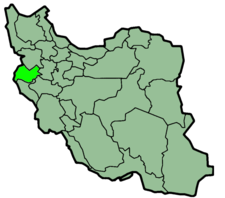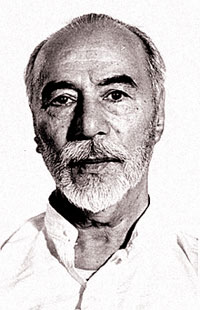
Hajj Nematollah
Encyclopedia

Jeyhounabad
Jeyhounabad is a city in Kermanshah Province , in the middle of the western part of Iran. It is from Tehran.The city lies in close proximity to Mount Bisotoun, known for its rock relief in which Darius the Great, the Achaemenian King, had the narrative of his exploits engraved around B.C. 500...
, Persia and is considered one of the greatest leaders and mystics in Kurdish and Ahl-e Haqq
Ahl-e Haqq
The Ahl-e Haqq or Yârsân , are members of a religion founded by Sultan Sahak in the late 14th century in western Iran. The total number of members is estimated at around 1,000,000, primarily found in western Iran and Iraq, mostly ethnic Kurds and Laks, though there are also smaller groups of Luri,...
history. Two of his most famous works of poetry and history are Furqān al-Akhbar (aka "The Firkan") and Ḥaqq al-Ḥaqāyiq yā Shāhnāmah-ʾi Ḥaqīqat. According to Encyclopædia Britannica, "The chief source of information about the Ahl-e Haqq is the Firqan al-Akhbar, written in... early 20th century by (Hajj Nemat)…"
Early life
Hajj Nemat's great-grandfather, Bayan Beg, accompanied Aga Abbas (one of the successors of Shah Hayas) to Jeyhounabad in the late 18th century. Bayan Beg's son, Esmail Beg, was Hajj Nemat’s grandfather.Nematollah Jeyhounabadi was born in 1871 (1288 Hijri calendar
Islamic calendar
The Hijri calendar , also known as the Muslim calendar or Islamic calendar , is a lunar calendar consisting of 12 lunar months in a year of 354 or 355 days. It is used to date events in many Muslim countries , and used by Muslims everywhere to determine the proper day on which to celebrate Islamic...
) in the small village of Kurdish Jeyhounabad. Before his birth, Persia was going through one of the worst droughts in history. His father, Bayan, named him Nematollah ("Grace of God") because on the day of his birth, Iran finally received the rain it so desperately needed.
In 1893 he married Sakina and they had their first child, Nur Ali Elahi, in 1895. At the age of thirty, during a grave illness, he claimed that he went on a journey to the beyond where he was appointed by God to announce the imminent return of the divine. Thousands of people flocked around him, and on his command ceased to take tea, tobacco and opium. He “believed the time had come to reveal the Real Truth”, and “by God’s command abandoned the world and became the messenger of the Lord of the Hour
Muhammad al-Mahdi
Muḥammad ibn al-Ḥasan al-Mahdī is believed by Twelver Shī‘a Muslims to be the Mahdī, an ultimate savior of humankind and the final Imām of the Twelve Imams...
”. After the advent was postponed twice, he went silent and waited for the Great Essence to appear.
His family

Nur Ali Elahi
Nur Ali Elahi was a spiritual thinker, musician, philosopher and jurist who dedicated his life to investigating the metaphysical dimension of human beings....
, Yar Ali, Bahram, and his daughters were Malak Jân Nemati
Malak Jân Nemati
Malak Jân Nemati was born in 1906 in Jeyhounabad, a village in Iranian Kurdistan. Also known as Sheikh Jâni and Saint Jani, she was a charismatic figure and a mystical writer and poet in Kurdish and Persian language. She was the daughter of Hajj Nematollah and the sister of Ostad Elahi. There are...
, Javaher, and Mariam. In the last few days of his life Hajj Nemat had predicted his own death. Within 48 hours of his death his first grandchild, Hajj Amin Elahi, was born.
Forqan ol-Akhbar
The original manuscript of Forqan ol-Akhbar was completed in 1910 by Hajj Nemat and is written in four parts. His son Nur Ali ElahiNur Ali Elahi
Nur Ali Elahi was a spiritual thinker, musician, philosopher and jurist who dedicated his life to investigating the metaphysical dimension of human beings....
wrote an introduction to Forqan ol-Akhbar and the biography of his father under the title of Kashf Al-Haqa’iq (which is approximately the first 14 pages of the manuscript, and features Nur Ali Elahi's calligraphy). Forqan ol-Akhbar is the only manuscript entirely handwritten by Hajj Nemat and is considered a historical masterpiece. Hajj Nemat gave the manuscript to Dr. Saeed Khan Kordestani in order for him to transport it to France to have it translated by Dr. Vladimir Minorsky. Unfortunately Dr. Minorsky died in 1966 before the manuscript was fully translated and published. After Minorsky’s death the manuscript became misplaced and remains unpublished as of this date.
Part one
The first part of Forqan ol-Akhbar deals with the fundamental principles of the haqiqat established in pre-eternity by the Divinity who in the stage of ya-yi ghaybat became externalized in the garment of Khawandagar. The law remained concealed till the coming of Sultan SahakSultan Sahak
Sultan Sahak, or Soltân Sahak was a religious leader who founded the secret and syncretistic religion of the Ahl-e Haqq, also known as the Yârsân. He is considered to be the manifestation of the total divine essence by the Ahl-e Haqq...
. Then the daftardars recorded these doctrines, but each in his own way and according to the sources which were accessible to him. As a result the Ahl-e Haqq community has no single sacred book, and its divisions are distinguished by different views. The Ahl-e Haqq required a kutb-I kull which would be unique. So after 1324/1906 Ne’matollah, by God’s command, abandoned the world and became the "messenger of the Lord of the hour", of Pir Benyamin (explained as bin + ya + amin "faithful son of Ya"). Then comes the explanation of reincarnation
Reincarnation
Reincarnation best describes the concept where the soul or spirit, after the death of the body, is believed to return to live in a new human body, or, in some traditions, either as a human being, animal or plant...
(gardish-e dun be-dun, "going from one garment to another"). The creatures of the world are divided into two distinct categories according to their original element (zarda-gil or khak-i siyah). To the first belong the saved and luminous beings, whose receptive sardar
Sardar
Sardar is a title of Indo-Aryan origin that was originally used to denote feudal princes, noblemen, and other aristocrats. It was later applied to indicate a Head of State, a Commander-in-chief, and an Army military rank...
s are Benyamin and Sayyid Muhammad (in his Avatar
Avatar
In Hinduism, an avatar is a deliberate descent of a deity to earth, or a descent of the Supreme Being and is mostly translated into English as "incarnation," but more accurately as "appearance" or "manifestation"....
of Buzurg-sawar). To the other category belong beings of fire and darkness whose respective sardars are Iblis and Khannas, with whom are associated the first three caliph
Caliph
The Caliph is the head of state in a Caliphate, and the title for the ruler of the Islamic Ummah, an Islamic community ruled by the Shari'ah. It is a transcribed version of the Arabic word which means "successor" or "representative"...
s, Mu’awiya, Aisha
Aisha
Aisha bint Abu Bakr also transcribed as was Muhammad's favorite wife...
, etc. The intermixture of the two categories of beings produces combinations which may be externally recognized.
Part two
The second part of the treatise is mainly concerned with the correspondence of the avatars through the ages. Thus manifestations of Benyamin are NoahNoah
Noah was, according to the Hebrew Bible, the tenth and last of the antediluvian Patriarchs. The biblical story of Noah is contained in chapters 6–9 of the book of Genesis, where he saves his family and representatives of all animals from the flood by constructing an ark...
, Jesus
Jesus
Jesus of Nazareth , commonly referred to as Jesus Christ or simply as Jesus or Christ, is the central figure of Christianity...
and provisionally (mihman) Rustam of the Persian epic; those of Razbar: Bilkis
Sheba
Sheba was a kingdom mentioned in the Jewish scriptures and the Qur'an...
, the Queen of Saba; Mary
Mary (mother of Jesus)
Mary , commonly referred to as "Saint Mary", "Mother Mary", the "Virgin Mary", the "Blessed Virgin Mary", or "Mary, Mother of God", was a Jewish woman of Nazareth in Galilee...
, the mother of Jesus, etc.; those of Sayyid Muhammad: Zoroaster
Zoroaster
Zoroaster , also known as Zarathustra , was a prophet and the founder of Zoroastrianism who was either born in North Western or Eastern Iran. He is credited with the authorship of the Yasna Haptanghaiti as well as the Gathas, hymns which are at the liturgical core of Zoroastrianism...
, Muhammad
Muhammad
Muhammad |ligature]] at U+FDF4 ;Arabic pronunciation varies regionally; the first vowel ranges from ~~; the second and the last vowel: ~~~. There are dialects which have no stress. In Egypt, it is pronounced not in religious contexts...
, etc. Next we are given the history of Sultan Sahak
Sultan Sahak
Sultan Sahak, or Soltân Sahak was a religious leader who founded the secret and syncretistic religion of the Ahl-e Haqq, also known as the Yârsân. He is considered to be the manifestation of the total divine essence by the Ahl-e Haqq...
(Ishak) and of his successors.
Part three
The third part relates the personal experiences of Hajj Ne’matollah and the commandments which he received from God during his journey to the beyond (safar-I ukba), notably his mission to unite the 12 Ahl-e Haqq khanadans, to give absolution from sins (az khiyanat pak namudan) and to intercede (shifa’at) with the Lord of Time.Part four
The fourth part is a full description of rites and customs (amr wa-nahy), with the Gurani text of the formulae recited on each occasion.Ḥaqq al-Ḥaqāyiq yā Shāhnāmah-ʾi Ḥaqīqat
The style of Ḥaqq al-Ḥaqāyiq yā Shāhnāmah-ʾi Ḥaqīqat is poetic. There is an entire chapter about AliAli
' |Ramaḍān]], 40 AH; approximately October 23, 598 or 600 or March 17, 599 – January 27, 661).His father's name was Abu Talib. Ali was also the cousin and son-in-law of the Islamic prophet Muhammad, and ruled over the Islamic Caliphate from 656 to 661, and was the first male convert to Islam...
, "The beginning was Ali and the end is Ali. Both worlds are luminous from the light of Ali. Ali is the manifestation of the pure essence of God, He is the King and Lord of both worlds. A sparkle of His essence, like the sun appeared at my time. I became so illuminated by him, that I knew of no God, other than Him."
Other works
Hajj Nemat wrote about 20 books and essays. Among them is Edalat Nameh (The book of Justice) which is concerning government. Forqan ol-Akhbar, Shah-Nama, and Kuch-e Kurdi (in Kurdish verse) are all about the same subject. He also has a "Masnavi" in Persian and there is a book of his predictions. In this book, the duration of the Pahlavi dynastyPahlavi dynasty
The Pahlavi dynasty consisted of two Iranian/Persian monarchs, father and son Reza Shah Pahlavi and Mohammad Reza Shah Pahlavi The Pahlavi dynasty consisted of two Iranian/Persian monarchs, father and son Reza Shah Pahlavi (reg. 1925–1941) and Mohammad Reza Shah Pahlavi The Pahlavi dynasty ...
and their destiny in World War II
World War II
World War II, or the Second World War , was a global conflict lasting from 1939 to 1945, involving most of the world's nations—including all of the great powers—eventually forming two opposing military alliances: the Allies and the Axis...
can be found and there are also predictions about World War III and other subjects.

